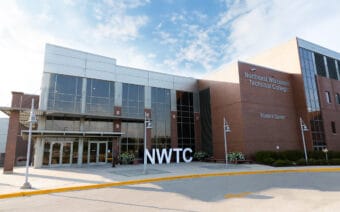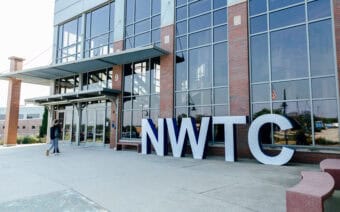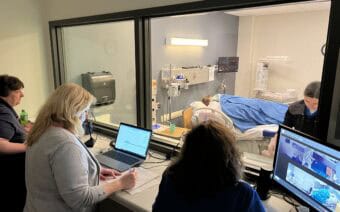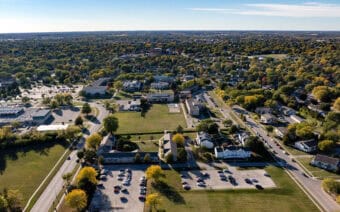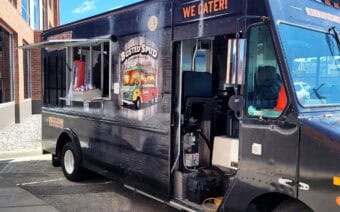
November 3, 2022
SEVASTOPOL – A simple search for trade-skilled vacancies in Northeast Wisconsin on Indeed.com populates a laundry list of opportunities – many from companies in Door County.
“Right now, my understanding is we can’t produce enough machinists to fill all the openings that there are,” Troy Schaefer, principal of the School District of Sevastopol, said.
With a dual purpose in mind – help build the supply of trade-skilled workers and provide high school students with an opportunity to earn high school and college credit – Northeast Wisconsin Technical College (NWTC) and Sevastopol High School have launched the Door County Machining Program.
The program – which gives students the opportunity to earn up to 16 credits toward an NWTC Machine Tool CNC Technician technical diploma – is available to junior and senior students within the Sevastopol, Sturgeon Bay, Southern Door and Gibraltar school districts.
“This expanded availability makes it a dynamic program to serve students throughout Door County,” Schaefer said.
Which April Konitzer, regional manager for NWTC’s Sturgeon Bay campus, said is exactly the intended goal.
“I think there’s a time and a place for everything,” she said. “Whenever we can bring it closer where they can get engaged sooner and be committed. I think it ups the investment they make in their own learning. So, that’s where I see a lot of value.
Kathryn Rogalski, NWTC vice president of student learning, said it’s always exciting when NWTC can work closely with its K-12 partners and industry businesses to focus on what the region needs.
“From what I know about the region, we can’t fill the machinists jobs in Door County quick enough with our current programs,” she said. “One of the benefits of having dual credit in the high schools and getting students knowledgeable about these types of careers that are in high demand in their area is that after high school, not only do they have college credits that lead them into a pathway where they can finish a degree, but they also have skills that they can go right to work.”
Rogalski said students that participate in dual credit, and who stay at the technical college generally work in their region and don’t leave.
//s3.amazonaws.com/appforest_uf/f1667482814097x318069665684371800/richtext_content.webpKathryn Rogalski said providing this program within the School District of Sevastopol provides students with an awareness of trade-skilled opportunities they may not be already familiar with. Submitted Photo
“This opportunity allows us to help the high school students see this career that has a real strong need in their own communities, fill those needs and stay local.”
Konitzer said the partnership also allows NWTC to provide more opportunities for learning in a cost-effective manner.
“When we can utilize existing resources to help fulfill workforce needs makes more sense than us trying to solve that situation ourselves as an institution,” she said. “Work with our K-12 partners, we can do that more efficiently and obviously it’s a better use of taxpayer dollars.”
A long plan
Sevastopol Superintendent Kyle Luedke said work toward making an opportunity like the Door County Machining Program a reality began several years ago.
“We passed the referendum for $25.1 million and Therma-Tron-X, Inc. (a local manufacturing company that specializes in industrial finishing systems, water treatment and wastewater treatment systems) gave us $2 million dedicated toward enhancing our industrial arts wing,” he said.
Luedke said Therma-Tron-X made the pledge in 2018 and made the program possible.
“Without that donation and the new industrial arts wing, I don’t know if the program would have fruited or it definitely would have been held here,” he said.
Rogalski said the program was essentially initiated by the business community.
“They contributed to a referendum that was already in progress and helped them see a vision of what they could offer in their tech ed area,” she said. “Rather than thinking the same kind of approach that is typical in a K-12 situation, they encourage the school district to think differently.”
Rogalski said that is what got the ball rolling.?
“(The district) realized they needed the expertise of others in order to make it reflective of industry needs,” she said. “So, they brought in NWTC, and our faculty and our associate deans from the trades area to help (guide them in deciding) what type of equipment we need, what is the curriculum we want to cover and then from there, bringing in other businesses to help support them… and be a conduit for students to see the real world applications.”
Rogalski said providing this program within the School District of Sevastopol provides students with an awareness of trade-skilled opportunities they may not be already familiar with.
“Sometimes careers like these, all of the students don’t necessarily know what they are,” she said. “One of the things we find is if we put the curriculum in the high school, then so many more students are exposed to something they might not ever think about when they were going to college. So this offers an opportunity for them to learn more about the different opportunities and then to engage in them differently and find out early.”
Rogalski said whether that means they continue on with it, or just as valuable, find out it’s not a good fit for them, the program allows them to figure that out early on.
“I think it’s a great opportunity for high school students to engage in many different thoughts about what their future is, and this gives them a different perspective on that,” she said.
Schaefer said the program is important on a lot of levels – “because not every student that attends high school is planning on having another four years of their life at a four-year college.”
“If you’re a young person that is like, ‘Man, I don’t want to go to a four-year college, and I think this is a skill set or career opportunity, a career field I could really excel in and do some great things.’ I mean, it’s pretty alluring to know you can be a young person working a full-time job.”
A balanced schedule
The Door County Machining Program is an add-on to a student’s current high school schedule.
Schaefer said the program runs from 7:30-10:30 a.m., then students transition back to their general education classes – either at Sevastopol if they are a student there, or return to their home district for the remainder of the day.
He said students are also required to earn all high school credits in order to graduate.
“For example, they need four credits of English to graduate here at Sevastopol, three credits of math – those things have to also be in line in order for them to be on track,” he said.
Rogalski said sign-up happens through the state’s Start College Now program – which is then approved by the student’s home district school board.
“There are two times of the year students are able to submit to their school district they’re interested in going through this program,” she said. “So, the school districts support the cost of the student participating through their own funds as part of Start College Now in the State of Wisconsin.”

Those involved said partnerships like the one between Sevastopol High School and Northeast Wisconsin Technical College help provide a pathway to students’ academic success. Submitted Photo
Konitzer said one of the unique things about the program is that since students are signed up for it through NWTC, they are NWTC students as well as high school students.
“Since they are filling out the application process and being dual credit students, they are NWTC students as well,” she said. “So, the credits they earn in high school, they’ll see on their high school transcript, but then they also see them on their college transcript… So it makes it easy for them to get on that path and stay on the path.”
Only the beginning
Rogalski said the inaugural class has six students – all seniors – from a handful of districts participating.
But all involved said this is just the beginning.
“When we worked with the school districts, a plan was generated for the next three to five years of what it would be like — our minimum number of students we would like to see in the classes, etc.,” she said. “So, this year, we started with six, which was what our goal was, so that’s wonderful. I believe our capacity in there is 12, so that’s what we want to hope to get to.”
Rogalski said there are also hopes for the future to use that lab to continue.
“So, right now, the students earn about one semester in the machining program, which gets them off to a great start, gives them a lot of skills, gives them those entry-level skills to start in the field,” she said. “But what we want to do is also then utilize this lab to provide continuing education and to keep going.”
Rogalski said this would mean allowing students to come back after they graduate on off hours and complete the program.
“So that’s a great opportunity,” she said. “And that’s not only for high school students. That’s for community members as well, because Sevastopol has been, and the industry partners have been, open to how we can continue this and grow this. So there are possibilities for the future.”
Konitzer said the Door County Machining Program is a roadmap, or model, for future partnerships.
“I think what we realized is it takes all of those entities to be involved in this type of offering to make it successful,” she said. “The businesses are invested. You know the school districts have become invested. And of course, we are, too. It creates a better pathway kids can see. And like I said, it’s a model for other programs we want to bring forth in the future.”
Schaefer said there are opportunities for students to pair the experience they are getting through the program with a youth apprenticeship program.
An open house of the space at Sevastopol was held at the end of last month, partially, Rogalski said, as a celebration of reimagining how “we’re offering education and building the talent pipeline we need to do in our region.”
https://s3.amazonaws.com/appforest_uf/f1667482916654x865112803996886900/richtext_content.webpStudents from high schools throughout Door County are participants in the inaugural year of the Door County Machining Program. Submitted Photo
“The traditional education model is – you go to high school, you go to college then you go to work; or you go to high school and then you go to work,” she said. “This is looking at it differently and saying, ‘we want you to go to high school. We also want you to get college classes that will build toward a career that will enable you to have a wage that will sustain your family.”
Konitzer said the open house was also a signal to the community to let them know it’s here.
“This is (the community’s) opportunity to take a look at this and (ask themselves) is this something your son or daughter might be interested in and put the message out that it’s running and it’s successful.”
 Making IT personal for 25 years
Making IT personal for 25 years Chamber business survey: ‘Very positive news’ for 2025
Chamber business survey: ‘Very positive news’ for 2025

